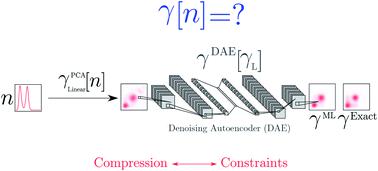当前位置:
X-MOL 学术
›
Faraday Discuss.
›
论文详情
Our official English website, www.x-mol.net, welcomes your feedback! (Note: you will need to create a separate account there.)
Insights into one-body density matrices using deep learning.
Faraday Discussions ( IF 3.4 ) Pub Date : 2020-06-12 , DOI: 10.1039/d0fd00061b Jack Wetherell 1 , Andrea Costamagna , Matteo Gatti , Lucia Reining
Faraday Discussions ( IF 3.4 ) Pub Date : 2020-06-12 , DOI: 10.1039/d0fd00061b Jack Wetherell 1 , Andrea Costamagna , Matteo Gatti , Lucia Reining
Affiliation

|
The one-body reduced density matrix (1-RDM) of a many-body system at zero temperature gives direct access to many observables, such as the charge density, kinetic energy and occupation numbers. It would be desirable to express it as a simple functional of the density or of other local observables, but to date satisfactory approximations have not yet been found. Deep learning is the state of the art approach to performing high dimensional regressions and classification tasks, and is becoming widely used in the condensed matter community to develop increasingly accurate density functionals. Autoencoders are deep learning models that perform efficient dimensionality reduction, allowing the distillation of data to the fundamental features needed to represent it. By training autoencoders on a large data-set of 1-RDMs from exactly solvable real-space model systems, and performing principal component analysis, the machine learns to what extent the data can be compressed and hence how it is constrained. We gain insight into these machine learned constraints and employ them to inform approximations to the 1-RDM as a functional of the charge density. We exploit known physical properties of the 1-RDM in the simplest possible cases to perform feature engineering, where we inform the structure of the models from known mathematical relations, allowing us to integrate existing understanding into the machine learning methods. By comparing various deep learning approaches we gain insight into what physical features of the density matrix are most amenable to machine learning, utilising both known and learned characteristics.
中文翻译:

使用深度学习洞悉单身密度矩阵。
多体系统在零温度下的单体降低密度矩阵(1-RDM)可直接访问许多可观测值,例如电荷密度,动能和占有数。希望将其表示为密度或其他局部可观测值的简单函数,但迄今为止尚未找到令人满意的近似值。深度学习是执行高维回归和分类任务的最新方法,并且已在凝聚态物质社区中广泛使用,以开发越来越精确的密度泛函。自动编码器是深度学习模型,可以执行有效的降维,从而将数据提炼为表示数据所需的基本特征。通过训练来自可精确求解的真实空间模型系统的1-RDM大型数据集上的自动编码器,并执行主成分分析,机器可以了解数据可以压缩到何种程度以及如何对其进行约束。我们深入了解了这些机器学习的约束条件,并利用它们将1-RDM的近似值告知电荷密度的函数。我们在最简单的情况下利用1-RDM的已知物理属性来执行特征工程,在该过程中,我们从已知的数学关系中告知模型的结构,从而使我们能够将现有的知识整合到机器学习方法中。通过比较各种深度学习方法,我们可以洞悉密度矩阵的哪些物理特征最适合机器学习,
更新日期:2020-06-12
中文翻译:

使用深度学习洞悉单身密度矩阵。
多体系统在零温度下的单体降低密度矩阵(1-RDM)可直接访问许多可观测值,例如电荷密度,动能和占有数。希望将其表示为密度或其他局部可观测值的简单函数,但迄今为止尚未找到令人满意的近似值。深度学习是执行高维回归和分类任务的最新方法,并且已在凝聚态物质社区中广泛使用,以开发越来越精确的密度泛函。自动编码器是深度学习模型,可以执行有效的降维,从而将数据提炼为表示数据所需的基本特征。通过训练来自可精确求解的真实空间模型系统的1-RDM大型数据集上的自动编码器,并执行主成分分析,机器可以了解数据可以压缩到何种程度以及如何对其进行约束。我们深入了解了这些机器学习的约束条件,并利用它们将1-RDM的近似值告知电荷密度的函数。我们在最简单的情况下利用1-RDM的已知物理属性来执行特征工程,在该过程中,我们从已知的数学关系中告知模型的结构,从而使我们能够将现有的知识整合到机器学习方法中。通过比较各种深度学习方法,我们可以洞悉密度矩阵的哪些物理特征最适合机器学习,


























 京公网安备 11010802027423号
京公网安备 11010802027423号